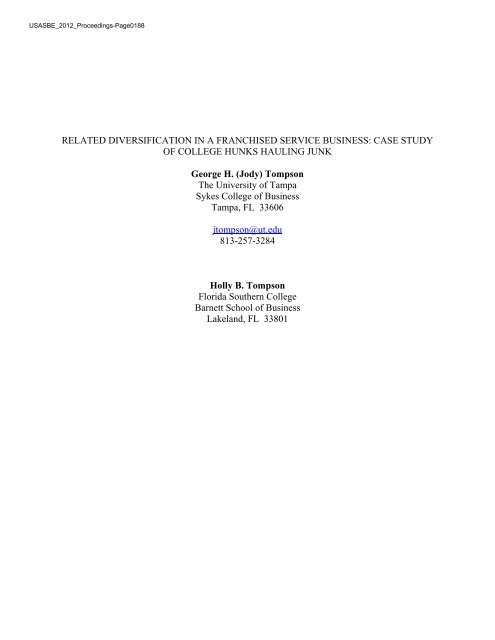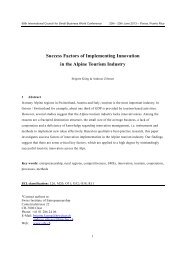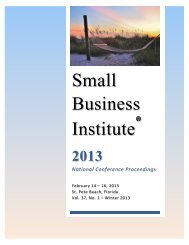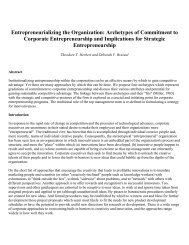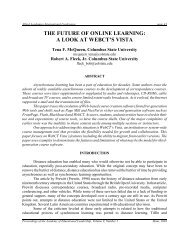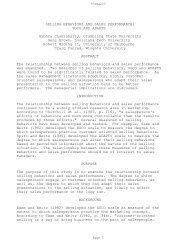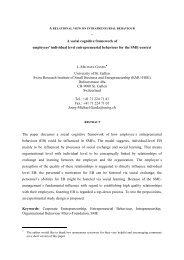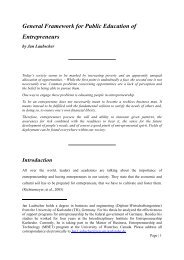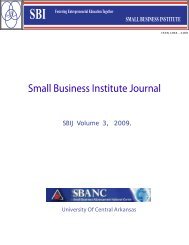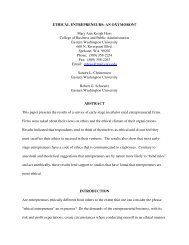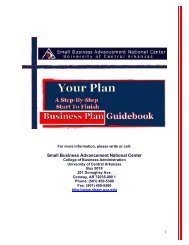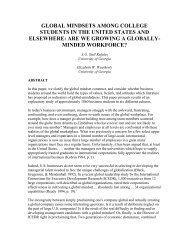related diversification in a franchised service business
related diversification in a franchised service business
related diversification in a franchised service business
Create successful ePaper yourself
Turn your PDF publications into a flip-book with our unique Google optimized e-Paper software.
USASBE_2012_Proceed<strong>in</strong>gs-Page0188<br />
RELATED DIVERSIFICATION IN A FRANCHISED SERVICE BUSINESS: CASE STUDY<br />
OF COLLEGE HUNKS HAULING JUNK<br />
George H. (Jody) Tompson<br />
The University of Tampa<br />
Sykes College of Bus<strong>in</strong>ess<br />
Tampa, FL 33606<br />
jtompson@ut.edu<br />
813-257-3284<br />
Holly B. Tompson<br />
Florida Southern College<br />
Barnett School of Bus<strong>in</strong>ess<br />
Lakeland, FL 33801
USASBE_2012_Proceed<strong>in</strong>gs-Page0189<br />
Related Diversification <strong>in</strong> a Franchised Service Bus<strong>in</strong>ess:<br />
Case Study of College Hunks Haul<strong>in</strong>g Junk<br />
Academic Abstract<br />
College Hunks Haul<strong>in</strong>g Junk (CHHJ) was founded <strong>in</strong> 2005 by two friends from Wash<strong>in</strong>gton,<br />
D.C. By 2009 the company had moved its headquarters to Tampa, FL, and had appeared on the<br />
Inc 500 list of fastest grow<strong>in</strong>g companies <strong>in</strong> America. Its founders had appeared on TV as guests<br />
of Oprah, Shark Tank, and Millionaire Matchmaker. However, by the end of 2009, CHHJ had<br />
lower revenue than 2008 and many franchisees were not earn<strong>in</strong>g the <strong>in</strong>come that they expected.<br />
This case presents the decision about whether CHHJ should consider diversify<strong>in</strong>g its range of<br />
<strong>service</strong>s to cont<strong>in</strong>ue grow<strong>in</strong>g its revenue.
USASBE_2012_Proceed<strong>in</strong>gs-Page0190<br />
Related Diversification <strong>in</strong> a Franchised Service Bus<strong>in</strong>ess:<br />
Case Study of College Hunks Haul<strong>in</strong>g Junk<br />
Executive Summary<br />
College Hunks Haul<strong>in</strong>g Junk (CHHJ) was founded <strong>in</strong> 2005 by two friends from Wash<strong>in</strong>gton,<br />
D.C. By 2009 the company had moved its headquarters to Tampa, FL, and had appeared on the<br />
Inc 500 list of fastest grow<strong>in</strong>g companies <strong>in</strong> America. Dur<strong>in</strong>g its first three years, the company’s<br />
revenue had grown about 65% per year. Dur<strong>in</strong>g the Great Recession the growth ceased and<br />
system wide revenue <strong>in</strong> 2009 was 19% less than 2008. But even before the slowdown, many<br />
franchisees were becom<strong>in</strong>g disillusioned that they were not earn<strong>in</strong>g as much money as they had<br />
hoped. By early 2010 the founders of the company, Nick Friedman and Omar Soliman, knew<br />
they needed to reassure the franchisees that the company would return to its growth trajectory<br />
that had looked so promis<strong>in</strong>g <strong>in</strong> the early years.<br />
The sole <strong>service</strong> of CHHJ has junk removal. Franchisees contracted with customers to clean out<br />
their attics, basements, garages, or offices. After the junk was removed, it was sorted accord<strong>in</strong>g<br />
to its worth. Useful items were donated to non-profit organizations, plastics and metals were<br />
recycled, and the rest was delivered to the municipal refuse collection system. For franchisees,<br />
the weakness <strong>in</strong> CHHJ’s bus<strong>in</strong>ess model was that most customers did not need frequent junk<br />
removal <strong>service</strong>s. Even when a customer was completely satisfied with the company’s <strong>service</strong>,<br />
he or she was not likely to become a repeat customer with<strong>in</strong> the same year.<br />
Dur<strong>in</strong>g 2010 the founders of CHHJ acknowledged that they needed to help the franchisees earn<br />
higher revenue. The case provides a description of the CHHJ bus<strong>in</strong>ess model and asks students<br />
to devise a plan for the company to diversify <strong>in</strong>to at least one other <strong>service</strong> that will provide the<br />
franchisees with a more consistent source of revenue. The case is targeted for use <strong>in</strong><br />
undergraduate courses <strong>in</strong> strategic management and entrepreneurship.<br />
INTRODUCTION<br />
Nick Friedman, co-founder of College Hunks Haul<strong>in</strong>g Junk hung up the phone. “Omar, I just<br />
got off a conference call with several franchisees. The frustration among them is grow<strong>in</strong>g. If we<br />
don’t help them raise their revenue, I th<strong>in</strong>k we might be fac<strong>in</strong>g a revolt early next year.” Omar<br />
Soliman was Nick’s bus<strong>in</strong>ess partner and co-founder. He expected this k<strong>in</strong>d of news. Dur<strong>in</strong>g<br />
2009 system-wide revenues for the company were 19% lower than 2008. Even before the Great<br />
Recession impacted the company, only a few of the franchisees were generat<strong>in</strong>g the revenue that<br />
they expected. Even if the recession ended tomorrow, Omar and Nick needed a plan to restore<br />
the franchisees’ confidence and grow the revenue of their young company.<br />
Background<br />
In 2003 Omar Soliman was a bus<strong>in</strong>ess management major at the University of Miami. Dur<strong>in</strong>g<br />
the summer after his junior year he started a bus<strong>in</strong>ess to make money for school. The concept<br />
was simple: identify<strong>in</strong>g customers who would pay for junk to be hauled away from their homes
USASBE_2012_Proceed<strong>in</strong>gs-Page0191<br />
or bus<strong>in</strong>esses. That summer, he borrowed the mov<strong>in</strong>g van that his mother used for her furniture<br />
bus<strong>in</strong>ess <strong>in</strong> Wash<strong>in</strong>gton, D.C. She needed the van only occasionally, and allowed him to use it<br />
when she did not need it. The bus<strong>in</strong>ess was more lucrative than he expected, so he began<br />
dream<strong>in</strong>g of bigger th<strong>in</strong>gs. When he returned to the University of Miami for his senior year, he<br />
heard about the bus<strong>in</strong>ess plan competition hosted by the college of bus<strong>in</strong>ess. He wrote a<br />
bus<strong>in</strong>ess plan describ<strong>in</strong>g College Hunks Haul<strong>in</strong>g Junk (CHHJ) and won the top prize <strong>in</strong> the<br />
competition, which was a check for $10,000. Soon after graduat<strong>in</strong>g, Omar reconnected with an<br />
old high school friend, Nick Friedman. Both had accepted corporate jobs after college, but<br />
neither was happy with their roles. They both had the urge to become entrepreneurs <strong>in</strong>stead.<br />
They decided to resign from their corporate jobs and found their company - Friedman and<br />
Soliman Enterprises, LLC - as the sole owner of College Hunks Haul<strong>in</strong>g Junk. Haul<strong>in</strong>g junk<br />
would no longer be merely a summer job, but would become a year-round bus<strong>in</strong>ess. In 2005 the<br />
company was founded <strong>in</strong> Wash<strong>in</strong>gton, D.C. They were both 25 years old at the time. Friedman<br />
and Soliman spent three years ref<strong>in</strong><strong>in</strong>g the bus<strong>in</strong>ess model, the brand, and build<strong>in</strong>g revenue. In<br />
those years, they were the only employees. They answered the phones, scheduled appo<strong>in</strong>tments,<br />
drove the truck, and hauled all the junk themselves. Omar recalled those early years.<br />
“Somehow we did a good job of look<strong>in</strong>g like a bigger, more sophisticated company.<br />
Most people did not seem to notice that the whole company was just Nick and me<br />
do<strong>in</strong>g all the work. One day we were driv<strong>in</strong>g down the road <strong>in</strong> our only truck when<br />
the cell phone rang. It was our only company phone and all customer calls came to<br />
it. Nick answered. A woman was call<strong>in</strong>g to say that one of the company trucks was<br />
driv<strong>in</strong>g erratically. Of course it was us she was report<strong>in</strong>g! Nick politely told her<br />
the driver would be reprimanded when he returned to headquarters!”<br />
In its early days, the <strong>service</strong> was very simple. CHHJ advertised locally via billboards, yard<br />
signs, and its website. Customers paid for junk removal by the cubic foot and could request<br />
removal of almost any household junk (anyth<strong>in</strong>g except hazardous waste).<br />
By 2008 Friedman and Soliman believed they had discovered a promis<strong>in</strong>g opportunity <strong>in</strong> a<br />
market that was underserved <strong>in</strong> many cities. They believed College Hunks could become a<br />
national company. They made the decision to move the company to Tampa, FL and beg<strong>in</strong><br />
aggressively sell<strong>in</strong>g franchises. See Table 1 for an overview of the company’s growth.<br />
Table 1: Growth of College Hunks Haul<strong>in</strong>g Junk<br />
Year Sales Franchises<br />
2005 $550,000 0<br />
2006 $1,100,000 0<br />
2007 $2,500,000 4<br />
2008 $3,000,000 14<br />
2009 $2,425,000 23<br />
Source: CHHJ <strong>in</strong>terviews<br />
STRATEGY & BUSINESS MODEL<br />
S<strong>in</strong>ce launch<strong>in</strong>g the company, Soliman and Friedman dreamed of creat<strong>in</strong>g a nationwide franchise<br />
system that provided junk removal <strong>service</strong>s to bus<strong>in</strong>esses and homeowners. Before CHHJ was
USASBE_2012_Proceed<strong>in</strong>gs-Page0192<br />
launched, the junk-haul<strong>in</strong>g profession was not occupied by clean-cut college men wear<strong>in</strong>g<br />
uniforms. Soliman and Friedman developed a differentiation strategy based on 1) a creative<br />
brand and memorable color schemes, 2) <strong>service</strong> that was courteous, punctual, and tidy, and 3) a<br />
<strong>franchised</strong> system that allowed franchisees to own exclusive rights to use the brand throughout a<br />
geographical region. See Appendix 1 for the CHHJ logo.<br />
Franchisees needed to <strong>in</strong>vest between $100,000 and $150,000 to f<strong>in</strong>ance the start-up of their own<br />
franchise. Franchisees received one week of tra<strong>in</strong><strong>in</strong>g at “Junk University” <strong>in</strong> Tampa and ongo<strong>in</strong>g<br />
support and market<strong>in</strong>g assistance via the toll free phone number and website. And each<br />
year, all the franchisees were <strong>in</strong>vited to Tampa for a long weekend at the Franchisees’<br />
Convention. There were opportunities for network<strong>in</strong>g, tra<strong>in</strong><strong>in</strong>g, celebrat<strong>in</strong>g, and peer coach<strong>in</strong>g.<br />
S<strong>in</strong>ce the beg<strong>in</strong>n<strong>in</strong>g, the founders of CHHJ have shown a knack for effective promotion and<br />
public relations. In 2008, Inc. named the founders among the “Top 30 Under 30,” which is the<br />
magaz<strong>in</strong>e’s award to cool young entrepreneurs (<strong>in</strong>c.com/30under30/2008/<strong>in</strong>dex.html). In the<br />
2009 version of the Inc 500 list, College Hunks Haul<strong>in</strong>g Junk was named as the 156 th fastest<br />
grow<strong>in</strong>g company <strong>in</strong> America and the second-fasted <strong>in</strong> Tampa Bay. The company is now the<br />
largest US-based company specializ<strong>in</strong>g <strong>in</strong> the bus<strong>in</strong>ess of junk and trash removal<br />
(http://www.<strong>in</strong>c.com/<strong>in</strong>c5000/2009/the-full-list.html). The founders have appeared on national<br />
television shows such as Oprah, SharkTank, and Millionaire Matchmaker. They have also been<br />
the subject of numerous local TV and newspaper stories.<br />
CHHJ operated a small corporate headquarters <strong>in</strong> Tampa (known as the “Client Loyalty<br />
Center”). The Center <strong>in</strong>cluded a call center to handle all the <strong>in</strong>com<strong>in</strong>g calls and email requests<br />
for junk haul<strong>in</strong>g <strong>service</strong>s. The requests were scheduled with the appropriate franchisee, and<br />
follow-up calls were made to every customer to assess the quality of the franchisee’s <strong>service</strong>. As<br />
of January 2010, CHHJ had franchises <strong>in</strong> 26 regions throughout the US. See Table 2 for a list of<br />
the franchise locations.<br />
Table 2: Franchise Locations <strong>in</strong> January 2010<br />
AR - Little Rock MD – Baltimore<br />
AZ - Phoenix MD- Howard County<br />
CA - Orange County MD- Wash<strong>in</strong>gton DC<br />
CA- Los Angeles MI - Oakland County<br />
CA- San Francisco NC- Raleigh/Durham<br />
CO- Denver NJ - Jersey<br />
FL-Ft. Meyers NJ-Hillsborough<br />
FL- Orlando OH- C<strong>in</strong>c<strong>in</strong>nati<br />
FL- Tampa OH- Columbus<br />
GA – Atlanta PA - Central PA<br />
IL- Chicago TX – Houston<br />
IN – Indianapolis TX- Dallas North<br />
KY- Louisville VA- Richmond
USASBE_2012_Proceed<strong>in</strong>gs-Page0193<br />
Franchis<strong>in</strong>g usually takes one of two forms. A product distribution franchise occurs when a<br />
franchisee buys the right to distribute a product or <strong>service</strong> however he wants. Accord<strong>in</strong>g to<br />
Shane, Shankar, and Arav<strong>in</strong>dakshan (2006:774) a bus<strong>in</strong>ess format franchise is a “network of<br />
legally <strong>in</strong>dependent organizations that jo<strong>in</strong>tly exploit a common asset--the franchisor's plan for<br />
the provision of a product or <strong>service</strong> to end customers. Under a bus<strong>in</strong>ess format franchise<br />
arrangement, the franchisee obta<strong>in</strong>s the right to use the franchisor's brand name and bus<strong>in</strong>ess<br />
plan <strong>in</strong> return for pay<strong>in</strong>g a royalty and franchise fees and agree<strong>in</strong>g to oversight by the<br />
franchisor.”<br />
To buy a CHHJ franchise, a person must pay $35,000 for exclusive rights to a geographic zone<br />
of operations. Any additional zones are discounted to a price of $15,000. In addition to the<br />
franchise fee, there are other start-up costs that a franchisee <strong>in</strong>curs, total<strong>in</strong>g between $100,000<br />
and $150,000. See Table 3 for a list of start-up expenses for a typical CHHJ franchisee.<br />
Table 3: Start-up Expenses for a CHHJ Franchisee<br />
Type of Expense Amount Explanation<br />
Initial franchise fee $35,000 Buy exclusive rights to a geographic region.<br />
Vehicle signage $900 - $1500 Logo signage and pa<strong>in</strong>t on the CHHL truck.<br />
Deposit / Down pymt $4500 - $12,000 Initial lease pymnt or down payment to<br />
on vehicle<br />
acquire a truck.<br />
Equipment & tools $600 - $2,000 Equipment for load<strong>in</strong>g junk <strong>in</strong>to truck.<br />
Office equip &<br />
supplies<br />
$1,400 - $2,000 Supplies for manag<strong>in</strong>g the franchise.<br />
Bus<strong>in</strong>ess license &<br />
permits<br />
$1000 - $3000 Fees vary by city and state<br />
Professional fees $1500 - $3500 Attorney and CPA fees for start-up.<br />
Insurance deposit $900 - $2000 Deposit on liability and workers comp policy.<br />
Tra<strong>in</strong><strong>in</strong>g expenses $2,200 - $4,000 Tra<strong>in</strong><strong>in</strong>g to learn how to manage the<br />
franchise.<br />
Grand Open<strong>in</strong>g $15,000 Advertis<strong>in</strong>g efforts to promote open<strong>in</strong>g of the<br />
advertis<strong>in</strong>g expenses<br />
franchise <strong>in</strong> the local community.<br />
Work<strong>in</strong>g capital $37k - $70k Estimated 3 months until break-even.<br />
After acquir<strong>in</strong>g a franchise, the franchisee must also pay ongo<strong>in</strong>g fees to the franchisor. See<br />
Table 4 for a list of those fees.
USASBE_2012_Proceed<strong>in</strong>gs-Page0194<br />
Table 4: CHHJ Franchise Fee Schedule<br />
Fee Name Amount Purpose<br />
Cont<strong>in</strong>u<strong>in</strong>g Royalty Fee 7% of Gross Payment to franchisor for the privilege of<br />
Sales us<strong>in</strong>g the bus<strong>in</strong>ess system.<br />
Client Loyalty Center Adm<strong>in</strong>. 6% of Gross Pays for adm<strong>in</strong>istration of the Client<br />
Fee<br />
Sales Loyalty Center on behalf of all franchisees.<br />
Also covers all software ma<strong>in</strong>tenance,<br />
supports licens<strong>in</strong>g fees for the proprietary<br />
software, and ma<strong>in</strong>tenance fees for the<br />
<strong>in</strong>tranet.<br />
Regional Advertis<strong>in</strong>g Fee 1% of Gross Fees used for creat<strong>in</strong>g and buy<strong>in</strong>g<br />
Sales advertis<strong>in</strong>g for a region, to benefit all the<br />
franchisees <strong>in</strong> the region.<br />
Local Advertis<strong>in</strong>g Fee 6% of Gross We may require our franchisees to form<br />
Sales regional advertis<strong>in</strong>g cooperatives <strong>in</strong> their<br />
local markets<br />
Selected F<strong>in</strong>ancial Information<br />
Based on historical <strong>in</strong>formation from exist<strong>in</strong>g franchisees, CHHJ has created a profile of the<br />
f<strong>in</strong>ancial results that a new franchisee can expect. See Table 5 for a pro forma P&L for a typical<br />
franchisee of CHHJ. Dur<strong>in</strong>g 2008 the average price per job was $304 but fell to $301 dur<strong>in</strong>g<br />
2009. Pric<strong>in</strong>g a job was estimated when the customer contacted the Customer Loyalty Center.<br />
But the price was not guaranteed until the franchisee arrived at the customer’s location. The<br />
f<strong>in</strong>al price of a job was based on the volume of junk that was to be loaded <strong>in</strong>to the CHHJ truck.<br />
- - - Insert Table 5 Here - - -<br />
JUNK REMOVAL INDUSTRY<br />
For centuries, junk removal was a do-it-yourself <strong>in</strong>dustry. Even today, most people remove the<br />
junk from their attics, garages, and storage units with the help of friends and family. Or maybe<br />
they hire a neighborhood high school boy. In recent years, however, there has been a trend<br />
toward national brand<strong>in</strong>g <strong>in</strong> <strong>in</strong>dustries that have historically been very fragmented and occupied<br />
by hundreds of sole proprietors or regional providers. For example, H&R Block <strong>in</strong> <strong>in</strong>come tax<br />
preparation, Merry Maids <strong>in</strong> home clean<strong>in</strong>g, TruGreen <strong>in</strong> lawn <strong>service</strong>, and Stanley Steamer <strong>in</strong><br />
carpet clean<strong>in</strong>g are all national brands that are leaders <strong>in</strong> fragmented <strong>in</strong>dustries.<br />
The world’s largest junk removal company is 1-800-GOT-JUNK? Like CHHJ, it was also<br />
started by a college student who was search<strong>in</strong>g for a way to earn extra money dur<strong>in</strong>g his summer<br />
vacation. The company was founded <strong>in</strong> 1989 <strong>in</strong> Vancouver, British Columbia by Brian
USASBE_2012_Proceed<strong>in</strong>gs-Page0195<br />
Scudamore when he was 18 years old. By 2009 it had more than 250 franchisees <strong>in</strong> Canada, the<br />
US, and Australia. Nick Friedman estimated that 1-800-GOT-JUNK earned annual revenue of<br />
around $80 million. The bus<strong>in</strong>ess models of the two companies were similar. Both were<br />
bus<strong>in</strong>ess format franchises that operate a centralized call center, national and regional<br />
advertis<strong>in</strong>g, unified brand<strong>in</strong>g and public relations, tra<strong>in</strong><strong>in</strong>g for franchisees, and similar capital<br />
requirements. Accord<strong>in</strong>g to its website, 1-800-GOT-JUNK required prospective franchisees to<br />
have about $95,000 <strong>in</strong> liquid capital to start a franchise. The franchise fee was $18,000 per<br />
region with additional regions cost<strong>in</strong>g $9,000 each. In many US markets, College Hunks<br />
Haul<strong>in</strong>g Junk and 1-800-GOT-JUNK were compet<strong>in</strong>g head-to-head.<br />
While 1-800-GOT-JUNK is the most visible competitor <strong>in</strong> the <strong>in</strong>dustry, CHHJ also faced<br />
competition from legions of regional and local companies. In every city, there were local junk<br />
haul<strong>in</strong>g <strong>service</strong>s that could be found by search<strong>in</strong>g the Yellow Pages, Yahoo Local, or Google.<br />
These competitors had a lower cost structure and could usually offer prices that undercut CHHJ.<br />
For example, the CHHJ franchisee <strong>in</strong> Orlando, FL faced competition from Orlando Lawn Patrol,<br />
LLC and Haul Away Harry’s. These companies appeared to have some market<strong>in</strong>g budget and<br />
some presence on the <strong>in</strong>ternet. Another tier of competitors existed at even a lower cost position.<br />
These were the casual or part-time <strong>service</strong> providers that might work only <strong>in</strong> their own<br />
neighborhoods. They were referred to as “a teenager with a pick-up truck” and typically had no<br />
<strong>in</strong>surance, no website, and no market<strong>in</strong>g efforts besides post<strong>in</strong>g signs on telephone poles. Entry<br />
barriers for these companies could hardly have been any lower, and they did provide a <strong>service</strong><br />
that was valuable to some customers. CHHJ was certa<strong>in</strong>ly aware of these providers and had<br />
<strong>in</strong>tentionally refused to cut prices to match them.<br />
STRATEGIC ISSUE<br />
When they moved their company to Tampa <strong>in</strong> 2008 Friedman and Soliman saw their roles as<br />
build<strong>in</strong>g an effective system so that their franchisees could become successful. The Tampa and<br />
Wash<strong>in</strong>gton locations were company-owned (<strong>in</strong>stead of franchises) but Friedman and Soliman<br />
removed themselves from runn<strong>in</strong>g the local bus<strong>in</strong>esses and hired managers <strong>in</strong>stead. The ma<strong>in</strong><br />
issue confront<strong>in</strong>g franchisees was f<strong>in</strong>d<strong>in</strong>g the optimal balance between pursu<strong>in</strong>g customer<br />
retention and customer acquisition (Peifer, 2005). Customer retention <strong>in</strong>volved build<strong>in</strong>g<br />
relationships with exist<strong>in</strong>g customers so that they ma<strong>in</strong>ta<strong>in</strong>ed loyalty, became repeat buyers, and<br />
spread positive word-of-mouth advertis<strong>in</strong>g about the company. Customer acquisition <strong>in</strong>cluded<br />
all the activities to encourage non-customers to abandon compet<strong>in</strong>g brands, or to enter the<br />
market for the first time.<br />
In the junk removal bus<strong>in</strong>ess, most customers were <strong>in</strong>frequent buyers. They might require junk<br />
removal <strong>service</strong>s once or twice per year, or maybe even less. Infrequent purchase was not<br />
usually due to poor <strong>service</strong> from CHHJ. Instead, people usually accumulate junk slowly and do<br />
not regularly need to pay for it to be removed. Consequently, CHHJ franchisees spent almost all<br />
their market<strong>in</strong>g resources on customer acquisition <strong>in</strong>stead of retention.
USASBE_2012_Proceed<strong>in</strong>gs-Page0196<br />
The Opportunity for Diversification<br />
When consider<strong>in</strong>g how to grow the bus<strong>in</strong>ess via new customer acquisition, a recurr<strong>in</strong>g question<br />
for Nick and Omar was whether to create a whole new <strong>service</strong> (or <strong>service</strong>s) that the franchisees<br />
could offer. Because junk removal was such an <strong>in</strong>frequent need for most people, franchisees<br />
struggled to earn a consistent stream of revenue. If they were able to offer other <strong>service</strong>s, they<br />
might acquire new customers more easily, and upsell more <strong>service</strong>s to exist<strong>in</strong>g customers too.<br />
The idea of provid<strong>in</strong>g an additional <strong>service</strong> (or <strong>service</strong>s) was appeal<strong>in</strong>g as a source of more<br />
consistent revenue, but the owners could foresee a difficulty <strong>in</strong> roll<strong>in</strong>g out a new <strong>service</strong> to all the<br />
exist<strong>in</strong>g franchisees. The franchisees had bought <strong>in</strong>to the system with the understand<strong>in</strong>g that<br />
they would be <strong>in</strong> the junk removal bus<strong>in</strong>ess. Some of them might be reluctant to provide new<br />
<strong>service</strong>s because it would require new tra<strong>in</strong><strong>in</strong>g, new equipment, and new market<strong>in</strong>g efforts.<br />
What would Nick and Omar do if the franchisees refused to expand? Nick and Omar wanted to<br />
offer new <strong>service</strong>s at their company-owned franchises (Tampa and Wash<strong>in</strong>gton, DC) but<br />
wondered how the expansion would be accepted by franchisees across the country.<br />
A typical franchisee had the follow<strong>in</strong>g resources at his disposal: employees who were<br />
accustomed to carry<strong>in</strong>g and load<strong>in</strong>g heavy objects, a small dump truck with enclosed sides (see<br />
Appendix 2), a call center that handled <strong>in</strong>com<strong>in</strong>g calls and booked reservations for franchisees, a<br />
brand that was well-recognized <strong>in</strong> some cities, and a network of like-m<strong>in</strong>ded franchisees who<br />
were expected to share new ideas. Most of the franchisees <strong>in</strong> the system were generat<strong>in</strong>g annual<br />
revenue of just under $100,000. Accord<strong>in</strong>g to the proforma statements (see Table 5), they were<br />
below the “average case” scenario that they were expect<strong>in</strong>g when the bought <strong>in</strong>to the franchise,<br />
so maybe most franchisees would be amenable to diversify<strong>in</strong>g <strong>in</strong>to another <strong>service</strong> or two.<br />
Nick and Omar knew their leadership and creativity would be tested <strong>in</strong> the upcom<strong>in</strong>g months.<br />
They were sure they needed to add a new <strong>service</strong> (or <strong>service</strong>s) to the junk haul<strong>in</strong>g <strong>service</strong> the<br />
CHHJ already provided. But what should it be? It needed to fit with the skills and resources the<br />
franchisees already owned, it needed to be affordable for the franchisee to <strong>in</strong>vest <strong>in</strong>to, and it<br />
needed to be someth<strong>in</strong>g that would generate more consistent revenue for the franchisees.
USASBE_2012_Proceed<strong>in</strong>gs-Page0197<br />
APPENDICES<br />
Appendix 1: College Hunks logo<br />
Appendix 2: CHHJ Truck
USASBE_2012_Proceed<strong>in</strong>gs-Page0198<br />
Table 5: F<strong>in</strong>ancial Scenarios for a CHHJ Franchisee<br />
Assumptions:<br />
Avg. job price $250 $300 $350<br />
Jobs per day 1 1.25 2.25<br />
Operat<strong>in</strong>g Days Per month 26 26 26<br />
Franchisee Annual Sales<br />
Cost of Sales<br />
Worst<br />
Case<br />
$78,000<br />
LABOR (assume 20%) 15,600<br />
Disposal (assume 9%) 7,020<br />
Total Cost of Sales<br />
Gross Profit<br />
Operat<strong>in</strong>g Costs<br />
Truck Payment (1 truck)<br />
22,620<br />
55,380<br />
10,200<br />
Office supplies 6,000<br />
Insurance (assume 1 truck) 4,200<br />
Royalty fees (7%) 5,460<br />
Call center fees (6%)<br />
Local Advertis<strong>in</strong>g fees<br />
4,680<br />
($1.5k/month)<br />
18,000<br />
National Ad fees (1%) 780<br />
Fuel (assume 6%) 4,680<br />
Bank Charges (assume 1.5%) 1,170<br />
Other 6,000<br />
Total Operat<strong>in</strong>g Costs<br />
NET PROFIT<br />
61,170<br />
(5,790)<br />
Average<br />
Case<br />
$117,000<br />
23,400<br />
10,530<br />
33,930<br />
83,070<br />
10,200<br />
6,000<br />
4,200<br />
8,190<br />
7,020<br />
18,000<br />
1,170<br />
7,020<br />
1,755<br />
6,000<br />
69,555<br />
13,515<br />
Best<br />
Case<br />
$245,700<br />
49,140<br />
22,113<br />
71,253<br />
174,447<br />
10,200<br />
6,000<br />
4,200<br />
17,199<br />
14,742<br />
18,000<br />
2,457<br />
14,742<br />
3,686<br />
6,000<br />
97,226<br />
77,222
USASBE_2012_Proceed<strong>in</strong>gs-Page0199<br />
REFERENCES<br />
Pfeifer, P. E. (2005). The optimal ratio of acquisition and retention costs. Journal of<br />
Target<strong>in</strong>g, Measurement and Analysis for Market<strong>in</strong>g, 13 (2), 179-188.<br />
Shane, Shankar, & Arav<strong>in</strong>dakshan. (2006). The effects of new franchisor partner<strong>in</strong>g strategies<br />
on franchise system size. Management Science, v52 i5 p773.<br />
Introduction<br />
TEACHING NOTE<br />
This case describes a real company fac<strong>in</strong>g a real dilemma dur<strong>in</strong>g the fourth year of its existence.<br />
The names of the company and its founders have not been changed. College Hunks Haul<strong>in</strong>g<br />
Junk, LLC is a <strong>franchised</strong> company that provides one <strong>service</strong>: haul<strong>in</strong>g away unwanted junk from<br />
homes and bus<strong>in</strong>esses. Throughout the system, franchisees have not usually been able to earn the<br />
revenue that they hoped when the bought <strong>in</strong>to the franchise. The primary reason is that they<br />
have discovered that almost none of their customers are repeat buyers. In most cases, people<br />
require junk removal <strong>service</strong>s only once every few years. The dilemma fac<strong>in</strong>g the founders<br />
(Nick Friedman and Omar Soliman) is whether to roll out additional <strong>service</strong>s for their<br />
franchisees to provide.<br />
Courses<br />
Previous versions of the case have been class-tested <strong>in</strong> undergraduate strategy and undergraduate<br />
entrepreneurship courses. It appeals to these students because 1) they can relate to two guys who<br />
started a bus<strong>in</strong>ess dur<strong>in</strong>g college and 2) CHHJ is a pretty simple bus<strong>in</strong>ess that has been<br />
successful so far. While mov<strong>in</strong>g junk from an attic to a truck is a simple job, design<strong>in</strong>g a<br />
strategy for <strong>related</strong> <strong>diversification</strong> is not simple. In our experience, a common weakness <strong>in</strong> the<br />
recommendations that undergraduates devise relates to feasibility. Their ideas are often creative<br />
and ambitious, but they are often unrealistic too. We have not tested the case with MBA<br />
students, but believe they might create a better balance of feasibility with their ideas for <strong>related</strong><br />
<strong>diversification</strong>.<br />
Role of the Authors<br />
One of the authors is on the company’s board of advisors and has <strong>in</strong>vited the founders to speak <strong>in</strong><br />
class on several occasions. The case study has developed over two years as the founders have<br />
made presentations to the students at the university.
USASBE_2012_Proceed<strong>in</strong>gs-Page0200<br />
Discussion and Analysis<br />
The decision issue is pretty clear <strong>in</strong> this case: how can the franchisor (CHHJ) help its franchisees<br />
<strong>in</strong>crease their revenue?<br />
1. What are the options for College Hunks Haul<strong>in</strong>g Junk to generate more revenue?<br />
In layman’s terms, CHHJ could 1) sell more <strong>service</strong>s to its exist<strong>in</strong>g customers & markets 2) sell<br />
its <strong>service</strong>s to new customers & markets 3) create new <strong>service</strong>s for its exist<strong>in</strong>g customers and<br />
markets, and 4) create new <strong>service</strong>s for new customers and markets.<br />
We recommend l<strong>in</strong>ger<strong>in</strong>g on this part of the question so that students can come up with the four<br />
options. Ideally, some students will see that CHHJ has been emphasiz<strong>in</strong>g options 1 and 2<br />
exclusively. But because of the nature of the <strong>service</strong>, recurr<strong>in</strong>g revenue has been very difficult to<br />
establish. This is a good time to emphasize to students that CHHJ is at a real <strong>in</strong>flection po<strong>in</strong>t <strong>in</strong><br />
its strategy. There almost certa<strong>in</strong>ly must be a big strategic change or the franchisees will not<br />
ever earn the returns that they were hop<strong>in</strong>g for.<br />
If the students remember their Pr<strong>in</strong>ciples of Market<strong>in</strong>g course, they might be familiar with the<br />
Ansoff Matrix shown below <strong>in</strong> Figure 1.<br />
Figure 1: The Ansoff Matrix<br />
This is a good tool for illustrat<strong>in</strong>g four dist<strong>in</strong>ct methods of growth. For the first several years,<br />
CHHJ pursued only the strategies <strong>in</strong> the left column of the matrix. Market Penetration offers<br />
only limited growth potential because most customers will need junk removal <strong>service</strong>s only once<br />
every few years. Market Penetration is effective, especially when a franchisee is able to get sales<br />
leads and referrals from satisfied customers. However, there is <strong>in</strong>tense competition from 1-800-<br />
GOT-JUNK <strong>in</strong> most markets. Furthermore, there are very powerful substitute products <strong>in</strong> most<br />
cities also. Depend<strong>in</strong>g on how much time you have for this case, there is an important diversion<br />
that you might want to take dur<strong>in</strong>g the discussion. You can start with a question such as “Why is<br />
the threat of substitute <strong>service</strong>s such a powerful force <strong>in</strong> this <strong>in</strong>dustry?” The answer, of course, is
USASBE_2012_Proceed<strong>in</strong>gs-Page0201<br />
that the barriers to entry are almost negligible for this <strong>in</strong>dustry. Any high school boy <strong>in</strong> a pickup<br />
truck can provide junk removal <strong>service</strong>s for people <strong>in</strong> his neighborhood. CHHJ has decided<br />
not to compete on price, so local substitute <strong>service</strong>s are almost always a lower-priced substitute<br />
than CHHJ.<br />
The right column is where Nick and Omar (the founders of CHHJ) are now work<strong>in</strong>g. They<br />
believe that only provid<strong>in</strong>g junk removal <strong>service</strong> has nearly reached its full potential. They do<br />
not want to discont<strong>in</strong>ue it, but believe that they should develop some additional <strong>service</strong>s to<br />
bolster the revenue and the image of the franchisees.<br />
2. What new <strong>service</strong>s should CHHJ develop?<br />
This question deserves a lot of analysis and th<strong>in</strong>k<strong>in</strong>g. If students have not prepared <strong>in</strong> advance to<br />
answer this question, then the discussion probably will be wide-rang<strong>in</strong>g and full of dead end<br />
ideas such as lawn mow<strong>in</strong>g, pool clean<strong>in</strong>g, dog-walk<strong>in</strong>g, and car wash<strong>in</strong>g. Consequently, we<br />
th<strong>in</strong>k this question should be explicitly assigned to the students before the day of the class<br />
discussion. It can also be the ma<strong>in</strong> question for a take home exam or a graded homework<br />
assignment.<br />
The first step <strong>in</strong> this process must be to determ<strong>in</strong>e how to make this decision. Specifically, the<br />
decision maker must develop criteria to which all solutions must be compared. NOTE: The<br />
<strong>in</strong>structor should decide whether to give the class this h<strong>in</strong>t about develop<strong>in</strong>g a list of criteria.<br />
Advanced students will already know that this is an important step but beg<strong>in</strong>ner students will<br />
need to be told to develop their list of criteria. The last sentence of the case vaguely describes<br />
the criteria that student should consider when devis<strong>in</strong>g a plan of new <strong>service</strong>s. The table below<br />
shows a list of criteria for guid<strong>in</strong>g the decision on what <strong>service</strong>s could be developed for the<br />
franchisees of College Hunks Haul<strong>in</strong>g Junk. Of course this list is not exhaustive – professors are<br />
encouraged to devise their own list us<strong>in</strong>g their understand<strong>in</strong>g of the case and of the concept of<br />
<strong>related</strong> <strong>diversification</strong>.<br />
Table 1: Suggested Criteria for Evaluat<strong>in</strong>g Options for New Services<br />
Criterion for New Service Rationale<br />
F<strong>in</strong>ancially feasible for franchisees.<br />
Goal of new <strong>in</strong>vestment < $10k per<br />
franchisee.<br />
Feasible for exist<strong>in</strong>g skill sets of<br />
employees.<br />
Franchisees have already <strong>in</strong>vested $100k -<br />
$150k to buy <strong>in</strong>to the bus<strong>in</strong>ess. Most of them<br />
have not been very successful so far, and<br />
probably don’t have the will<strong>in</strong>gness or<br />
resources to <strong>in</strong>vest heavily aga<strong>in</strong>.<br />
The franchisor will provide some tra<strong>in</strong><strong>in</strong>g for<br />
the new <strong>service</strong>. But the new <strong>service</strong> must be<br />
with<strong>in</strong> the realm of skills similar to the ones<br />
already <strong>in</strong> use. Currently, the “Hunks” are<br />
clean-cut, punctual, and courteous. Their first<br />
job is to verify that the cost estimate (given<br />
over the phone) is accurate. They either<br />
confirm the price estimate, or adjust it<br />
accord<strong>in</strong>g to the size of the job. Then they load<br />
junk <strong>in</strong>to the truck and haul it away.
USASBE_2012_Proceed<strong>in</strong>gs-Page0202<br />
Generates new source of revenue Junk haul<strong>in</strong>g <strong>in</strong>dustry has strong competitors,<br />
strong substitutes, and it provides <strong>in</strong>consistent<br />
revenue. For franchisees to earn annual<br />
revenue above $100k consistently, they must<br />
have another revenue stream to compliment<br />
junk haul<strong>in</strong>g.<br />
Fits with CHHJ resources The culture, the assets, the strategy, and the<br />
leadership of CHHJ is all designed to provide a<br />
differentiated <strong>service</strong>. The key physical<br />
resources are the trucks that the franchisees<br />
own and the reservation system that schedules<br />
appo<strong>in</strong>tments with customers (owned and<br />
managed by the franchisor).<br />
In a nutshell, the new <strong>service</strong> should make use of the CHHJ truck and the manual labor that is<br />
currently underutilized <strong>in</strong> most of the franchisees. Possible suggestions are:<br />
Lawn / yard ma<strong>in</strong>tenance – trucks can be used to carry equipment; the bus<strong>in</strong>ess provides<br />
recurr<strong>in</strong>g and regular revenue<br />
Swimm<strong>in</strong>g pool ma<strong>in</strong>tenance – same benefits of lawn and yard ma<strong>in</strong>tenance<br />
Snow plow<strong>in</strong>g – <strong>in</strong> northern states the truck can be outfitted with a removable snow plow<br />
Delivery <strong>service</strong> – truck can be used to deliver equipment or other bulky items<br />
On-site shredd<strong>in</strong>g – carry a commercial shredder to companies that need secure<br />
documents shredded.<br />
Local mov<strong>in</strong>g <strong>service</strong>s – good use of truck and labor. But <strong>in</strong>side of trucks tend to get<br />
dirty when they haul junk.<br />
The objective of this part of the case analysis should be to create defensible criteria, then choose<br />
the new <strong>service</strong> that best meets the criteria. In our experience, this can lead to a good discussion<br />
about “fit” if the students have spent some time evaluat<strong>in</strong>g the many options that are available to<br />
CHHJ.<br />
3. Should CHHJ consider any new <strong>service</strong>s that are not <strong>related</strong> to junk haul<strong>in</strong>g?<br />
This question can be used if time permits, or if the <strong>in</strong>structor wants to expand the discussion to<br />
<strong>in</strong>clude <strong>related</strong> vs. un<strong>related</strong> <strong>diversification</strong> strategies. All strategy textbooks will have a chapter<br />
or two on corporate-level strategy. One of the ma<strong>in</strong> topics is <strong>diversification</strong> <strong>in</strong>to <strong>related</strong><br />
products/<strong>service</strong>s (concentric) or <strong>diversification</strong> <strong>in</strong>to un<strong>related</strong> products/<strong>service</strong>s (conglomerate).<br />
This topic might be especially useful if students decide that CHHJ should diversify <strong>in</strong>to an<br />
un<strong>related</strong> <strong>service</strong> such as babysitt<strong>in</strong>g or pizza delivery.<br />
Epilogue<br />
Dur<strong>in</strong>g 2010 CHHJ launched “College Hunk Mov<strong>in</strong>g” as a test market <strong>in</strong> Tampa, FL. Results<br />
were stronger than expected dur<strong>in</strong>g the first half of the year, so a few other franchisees were<br />
approved to try it also. The results <strong>in</strong> Wash<strong>in</strong>gton DC and Atlanta were also positive so Nick<br />
and Omar began to plan how they could roll out the <strong>service</strong> nationwide. While one-way mov<strong>in</strong>g<br />
is similar to junk removal, there are costs and complications. In Tampa, the bus<strong>in</strong>ess purchased
USASBE_2012_Proceed<strong>in</strong>gs-Page0203<br />
a mov<strong>in</strong>g truck <strong>in</strong>stead of us<strong>in</strong>g the junk haul<strong>in</strong>g dump truck for two reasons. First, the dump<br />
truck is usually dirty on the <strong>in</strong>side and there was concern that customers would not appreciate<br />
their furniture be<strong>in</strong>g carried <strong>in</strong>side a filthy truck. Second, the mov<strong>in</strong>g truck has a capacity that is<br />
almost 100% larger than the dump truck. Of course the <strong>in</strong>surance coverage is more expensive,<br />
there are separate licenses to obta<strong>in</strong>, and the employees must be tra<strong>in</strong>ed to handle customer’s<br />
belong<strong>in</strong>gs much more carefully than the junk that they normally carry. Overall, 2010 has been a<br />
promis<strong>in</strong>g year and it looks like the College Hunks will beg<strong>in</strong> grow<strong>in</strong>g aga<strong>in</strong>.


